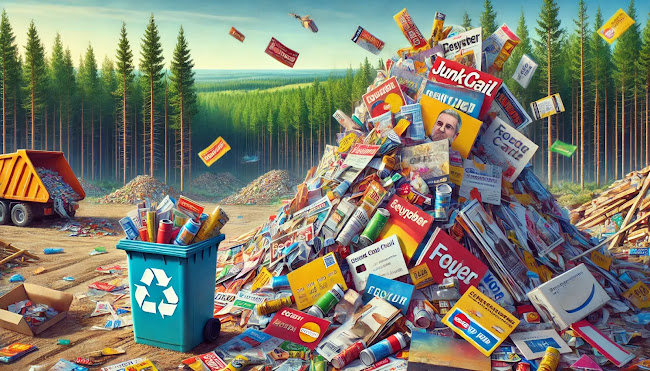Advertising Waste: How Packaging & Junk Mail Pollute the Planet
Every day, we are bombarded by advertising. From flashy product packaging on store shelves to stacks of unsolicited junk mail in our mailboxes, companies compete for our attention—often at the expense of the environment.
This relentless marketing machine generates millions of tons of waste every year. Much of it is single-use, destined for landfills or incinerators, polluting our air, water, and soil. Understanding the environmental impact of advertising waste is the first step toward making more sustainable choices.
 |
| image illustrating the environmental impact of advertising waste, featuring a landfill overflowing with colorful junk mail and discarded packaging. |
The Hidden Cost of Product Packaging
Walk down any supermarket aisle, and you’ll see a sea of brightly colored cardboard, plastic, and foil-wrapped goods. Companies design packaging not just to protect products, but to stand out and persuade consumers to buy.
But this visual marketing comes with a massive environmental price tag:
- Excessive Packaging: Many products are overwrapped in plastic, sealed inside a cardboard box, then wrapped again in plastic film—all for branding appeal.
- Non-Recyclable Materials: Foil coatings, plastic laminates, and mixed materials make packaging difficult or impossible to recycle.
- Short Lifespan: A package might be used for minutes or seconds before being discarded, yet it can take centuries to decompose.
- Microplastic Pollution: Plastic packaging breaks down into tiny particles that enter waterways, harming marine life and contaminating the food chain.
In the U.S. alone, over 80 million tons of packaging waste is generated annually, with less than half being recycled. citeturn0search1
Junk Mail: A Daily Source of Unwanted Waste
Junk mail is one of the most wasteful forms of advertising. Credit card offers, real estate flyers, store catalogs, and promotional postcards arrive unsolicited—and almost all of it ends up in the trash.
The statistics are staggering:
- Over 100 billion pieces of junk mail are sent in the U.S. every year. citeturn0search2
- Producing junk mail destroys 100 million trees annually. citeturn0search2
- Junk mail produces more than 51 million metric tons of greenhouse gases each year—equivalent to the emissions from nine million passenger cars. citeturn0search0
- Approximately 44% of junk mail is thrown away unopened. citeturn0search6
Even though much of this mail is paper-based, many contain plastic coatings, adhesives, and inks that make recycling difficult. Worse, bulk mail is often printed in excess, meaning tons of it never even reaches mailboxes—it goes straight to waste.
The Environmental Consequences of Advertising Waste
Both product packaging and junk mail contribute to:
- Deforestation: Trees are cut down for disposable advertising materials, disrupting ecosystems.
- Carbon Emissions: Manufacturing, printing, and transporting ads and packaging release greenhouse gases.
- Plastic Pollution: Single-use packaging breaks down into microplastics, entering oceans and drinking water.
- Landfill Overflow: Non-recyclable junk mail and packaging take up valuable landfill space.
What You Can Do to Reduce Advertising Waste
While advertising waste is a massive industry-driven issue, there are ways to reduce its impact in daily life:
Be a Conscious Consumer
- Choose products with minimal or no packaging: Opt for bulk items, refill stations, or products wrapped in paper.
- Look for items in 100% recyclable or compostable packaging: Support brands committed to sustainable packaging practices.
- Support brands committed to sustainable packaging practices: Your purchasing power can drive change.
Stop Junk Mail at the Source
- Opt out of pre-approved credit offers: Visit OptOutPrescreen.com to remove your name from mailing lists.
- Register with the DMA Choice program: Reduce promotional mail by managing your mail preferences.
- Contact local businesses: Request removal from mailing lists to stop receiving unsolicited mail.
- Use a "No Junk Mail" sign: Place a notice on your mailbox to deter local flyers.
Recycle & Repurpose
- Shred and compost paper junk mail: Ensure it's printed with non-toxic ink before composting.
- Use colorful packaging for crafts or storage: Get creative and give packaging a second life.
- Properly sort recyclables: Remove plastic coatings before disposal to ensure effective recycling.
Final Thoughts
Advertising waste is everywhere, but we don’t have to accept it as unavoidable. By making small changes—choosing sustainable products, reducing junk mail, and demanding responsible advertising practices—we can help cut down on the pollution caused by unnecessary marketing.
Every time you reject wasteful packaging or stop an unwanted mailer, you’re sending a message: The planet matters more than flashy ads.









Comments
Post a Comment